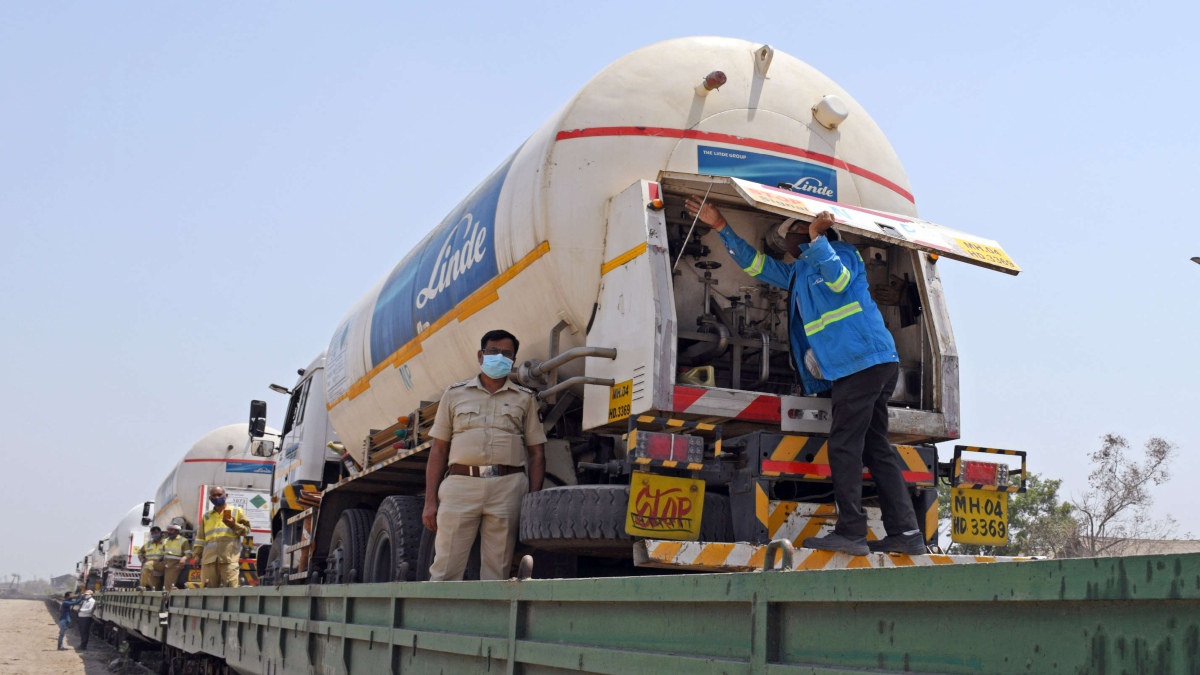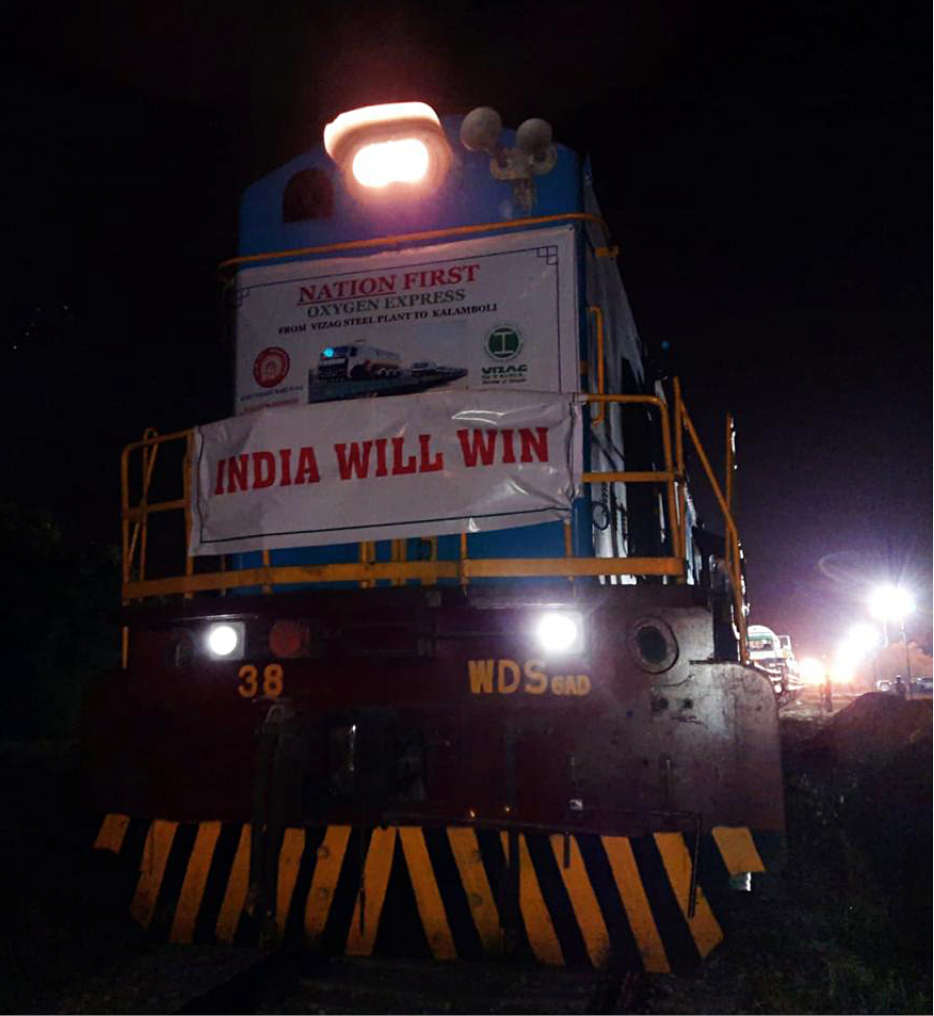


There is a video doing rounds on social media about the green corridor made by the Railways to transport Liquid Medical Oxygen (LMO). Where You Tuber Nitin Shukla is seen explaining the efficiency and planning of the Modi government, he claims while people like Arvind Kejriwal are busy buying fake credits the PM Modi and his team are efficiently delivering things silently. Let’s do fact-check whether his claims, praises are really praiseworthy or not.

On 15 April 2020 Maharashtra Government approached the Ministry of Railways to explore whether they can transport LMO tankers by rail from different oxygen generation facilities from across the country to different supply points in Maharashtra. Ministry of Railways immediately started to explore the feasibility on war footing about the route, working out the modalities and prepare a plan for the movement of tankers.
The main challenge in transporting Medical Oxygen Tankers is to find the shortest suitable railway route from origin to destination. The physical dimension of the tanker loaded on the railway wagon (Over Dimensional Consignment (ODC) in railway’s technical language can safely pass through various fixed railway installations without any infringement. There are several other constraints like the presence of low height fixed structures like Road over Bridges (ROB), low height overhead equipment wires, restrictions on bridges, curves, and running through platforms were examined expeditiously and a suitable route was identified from Mumbai to Visakhapatnam.
The next challenge is to identify suitable railway wagons, it was done quickly and a trial was organised at Boisar on 18 April. A loaded tanker was placed on the wagon and all the required measurements were taken. Specifications for checking/securing for the safety of the tanker during movement were successfully worked out by Railways and Industry representatives. The trial was successful, the first LMO Express was planned and started on 19 April.
In this LMO express from Mumbai to Vizag, it was ensured to select only those tankers which would not exceed the height beyond the A or B class ODC so that good speeds could be achieved. The availability of tankers of 3330 mm or lower were requested from the industry. But out of 12, only seven could meet the height criterion. Ramps were constructed within 24 hours to facilitate the loading of road tankers on rail wagons.
Efforts were made to ensure intensive monitoring and route mapping has ensured that the train could cover this distance in a short time. The top management of Railways i.e., the Railway Board, Zonal/Divisional level management have spent a lot of time to make this happen in the shortest time to bail out Mumbai city out of the oxygen crisis. This all was done despite Covid pandemic and shortage of working staff and resources and running all coaching and freight trains. This movement was successfully planned as a green initiative project (green corridor). This also required coordination with states, industry and other stakeholders viz Ministry of Road Transport & Highways & DPIIT etc.
The results were amazing too. Movement by Rail has proved to be faster than road tankers. Whereas average time taken by road tankers is close to 70 hours from Mumbai to Vizag (compared to 55 hours by rail) and we could transport more quantity of oxygen at a go.
This success led other state governments to approach the railway to arrange transportation of LMOs through Railway wagons. On the request of the UP government, one such train has left from Lucknow (U.P) to Bokaro on 22 April and reached Bokaro in the early hours of 23 April clocking an average speed of nearly 50 kmph despite the normal traffic on the rail route.
Requests are pouring in Uttar Pradesh and Andhra Pradesh to move Oxygen Express from Reliance Jamnagar Refinery to U.P and Angul (Odisha) to Vijaywada (A.P). Now Madhya Pradesh has also evinced interest and many more are in the queue to transport Medical Oxygen through railway wagons. But it’s equally important to mention here that Liquid oxygen is hazardous and its transportation requires stringent protocols such as the least sudden acceleration or brakes, restricted maximum speeds, avoiding sharp curves, pressure adjustments etc.
This quick and effective action is contrary to the rigid image Railways has been bearing for decades. They have shown proactiveness and flexibility in their approach to making this endeavour a success. The Maharashtra government has made last-minute changes in delivery points, has requested for a change in destination of loaded tankers from Vizag to Nagpur and Nashik which has also been accepted by Railways at short notice and route mapped accordingly.
Apart from this LMO transporting endeavour, Railways has made 3816 Coaches available as covid isolation care beds in different locations. The state governments have been apprised about the availability of coaches. So far only Delhi and Maharashtra demanded the coaches. Delhi has asked for 50 coaches (800 beds) at Shakur Basti and 25 coaches (400 beds) at Anand Vihar as on date no patient has been admitted to these care centres, despite the fact that Delhi seeing over 25,000 cases daily and need to utilise this facility.
Nandurbar (Maharashtra) has 21 coaches (378 beds) only 32 patients are admitted to these coaches.
To clear extra rush additional trains are being run from Railways during April-May 2021
• Central Railway – 130 trains (364 trips)
• Western Railway – 154 trains (212 trips)
• Northern Railway – 27 trains (27 trips)
• East Central Railway – 02 trains (4 trips)
• North Eastern Railway – 09 train (14 trips)
• North Central Railway – 01 train (10 trips)
• South Western Railway – 3 trains (30 trips)
• Total trains 328 (664 trips)
The trains are for destinations having high demand like Gorakhpur, Patna, Darbhanga, Muzaffarpur, Bhagalpur, Varanasi, Guwahati, Manduadih, Barauni, Prayagraj, Bokaro, Ranchi, Lucknow& Kolkatta as the workers are returning home due to fear of the pandemic.
This pandemic has made drastic changes in the approach of government working and has changed the mindset positively. Railways under the leadership of Piyush Goyal have broken the rigid boundaries set from a century-old pattern of working in this organisation. The praises showered by Youtuber Nitin Shukla are found genuine and appreciable.
Gopal Goswami is a research scholar.